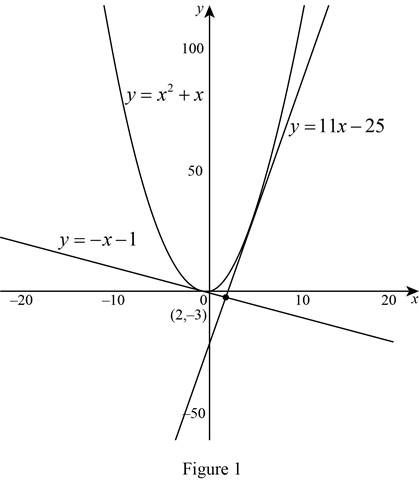
Concept explainers
(a)
To find: The equation of the tangent lines to the parabola through the points.
(a)
Answer to Problem 58E
The tangent line of curve at
The tangent line of curve at
Explanation of Solution
Given:
The parabola is
The parabola through the point is
Derivative rules:
(1) Power Rule:
(2)
Formula used:
The equation of tangent line at
Here, m is the slope of the tangent line at
Calculation:
The derivative of
Apply the sum rule (2).
Apply the power rule (1) and simplify the expression.
Therefore, the derivative of the parabola
Given parabola is
Obtain the equation of the tangent line to the parabola
The slope of the tangent line at
Thus, the slope of tangent line at
Note that, the slope of the line passing through the point
The tangent line passes through the point
Therefore, the slope
Compare the equations (2) and (3),
Cross multiply the equation and simplify the terms,
Solve the above equation and obtain
Substitute the values
Since the slope of the tangent line at
Substitute
The tangent line to the curve at
Substitute
The tangent line of curve at
The graph:
The graph of the curve and tangent line as shown below in Figure 1.

From Figure 1, it is observed that the lines
(b)
To show: There is no line through the point
(b)
Explanation of Solution
The given parabola is
Note that, the slope of the line passing through the point
The tangent line passing through the point
Therefore, the slope of the tangent line
From part (a), the slope of tangent line at
Then, the equation becomes,
Note that, the quadratic equation
Thus, the equation
Therefore, it is concluded that there is no line such that the tangent line passing through the point
Graph:
The graph of the parabola

From Figure 2, it is observed that there is no tangent line to the parabola through the point
Chapter 3 Solutions
Single Variable Calculus: Concepts and Contexts, Enhanced Edition
 Calculus: Early TranscendentalsCalculusISBN:9781285741550Author:James StewartPublisher:Cengage Learning
Calculus: Early TranscendentalsCalculusISBN:9781285741550Author:James StewartPublisher:Cengage Learning Thomas' Calculus (14th Edition)CalculusISBN:9780134438986Author:Joel R. Hass, Christopher E. Heil, Maurice D. WeirPublisher:PEARSON
Thomas' Calculus (14th Edition)CalculusISBN:9780134438986Author:Joel R. Hass, Christopher E. Heil, Maurice D. WeirPublisher:PEARSON Calculus: Early Transcendentals (3rd Edition)CalculusISBN:9780134763644Author:William L. Briggs, Lyle Cochran, Bernard Gillett, Eric SchulzPublisher:PEARSON
Calculus: Early Transcendentals (3rd Edition)CalculusISBN:9780134763644Author:William L. Briggs, Lyle Cochran, Bernard Gillett, Eric SchulzPublisher:PEARSON Calculus: Early TranscendentalsCalculusISBN:9781319050740Author:Jon Rogawski, Colin Adams, Robert FranzosaPublisher:W. H. Freeman
Calculus: Early TranscendentalsCalculusISBN:9781319050740Author:Jon Rogawski, Colin Adams, Robert FranzosaPublisher:W. H. Freeman
 Calculus: Early Transcendental FunctionsCalculusISBN:9781337552516Author:Ron Larson, Bruce H. EdwardsPublisher:Cengage Learning
Calculus: Early Transcendental FunctionsCalculusISBN:9781337552516Author:Ron Larson, Bruce H. EdwardsPublisher:Cengage Learning





